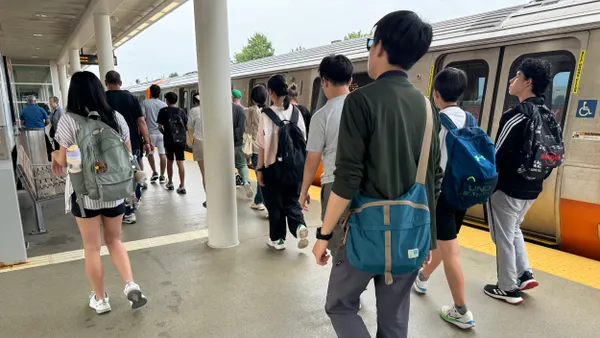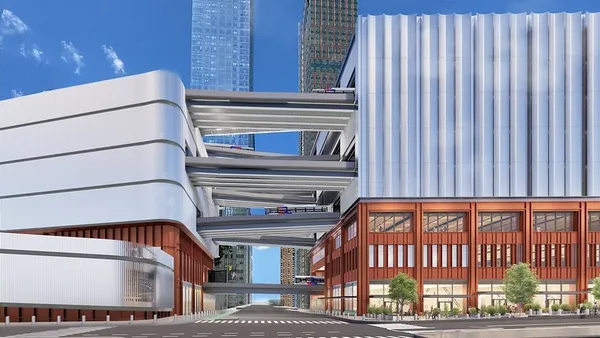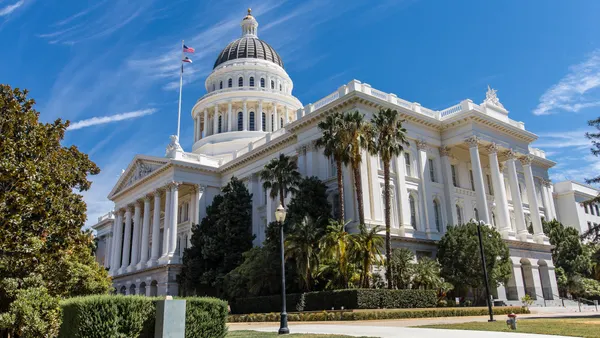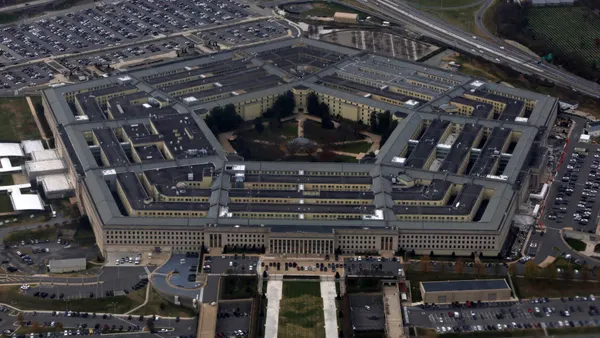What appears to be a partial draft of the White House’s $1 trillion infrastructure plan was leaked Monday, and it points to President Donald Trump's initial thoughts about paying for infrastructure with private funds. There is talk that Trump will provide an overview of the infrastructure bill during his State of the Union address next Tuesday — which is a measure of just how vital infrastructure is to the U.S.
In fact, a new study from AECOM, in which it surveyed more than 500 infrastructure professionals worldwide, found that more than 80% of those surveyed agree that national prosperity depends on civil infrastructure. "The Future of Infrastructure," which Construction Dive had an exclusive first look at, focuses on the problems, priorities and potential of delivering major infrastructure projects throughout the world. Although the labor shortage, maturation of digital technology and rapid urbanization all pose challenges, the most-cited challenges by far were funding and the investment gap.
With this report, AECOM aimed to provide the industry with a better understanding of the future. "We're at a critical moment for infrastructure," said Dan McQuade, group president for AECOM Construction Services. "We need the best minds thinking about how we’re going to address those challenges as an industry."
The Funding Gap
Research by the McKinsey Group estimates that nations need to invest an average total of $3.3 trillion each year to keep pace with projected worldwide growth through 2030. The Group of 20 (G-20) international forum believes $94 trillion is needed and that a $15 trillion gap must be bridged by 2037.
AECOM's report revealed 90% of respondents believe innovative funding models can be effective at bridging the gap. Traditional funding largely was through the public sector, but 39% cite the lack of public funding as a key reason why civil infrastructure isn't keeping up with current needs. Looking at new funding, 48% and 45% of U.S. respondents think P3s and toll-gathering solutions, respectively, could be options.
Time always is of the essence, too. "Fixing infrastructure before cost escalates further is really crucial," said Steve Morriss, group president, design and consulting services for Americas. "When you put a brilliant piece of infrastructure in a community, there is huge value in that for citizens and businesses. It creates future value. Trying to capture that future value and use it to kickstart the next level of infrastructure investment is key. We have to be flexible, committed and quick to getting tools in place."
But Trump's proposed infrastructure bill won’t be a cure-all to U.S. funding. "This is an issue that transcends any single bill, party or country," Morriss said. "The consistent view across the world is we need action and we need it now. There are a variety of ways in which it might come. No single piece of legislation will be the panacea, but we need to get the intensity, pace and creativity really motoring."
The Tech Component
"We used to think of infrastructure as roads and bridges," said McQuade. "That's part of it, but now we also have digital infrastructure. Infrastructure is anything that enables commerce. We have this unique tech revolution where physical and digital infrastructure have merged."
In addition to threats around physical infrastructure, there are new threats like cyber security and malware. "We’ve underinvested in infrastructure for years," he said. "Tech change has created a threat to prosperity and the ability to conduct business, move goods and function. If any of those big systems gets crippled by physical failure or a cyber-attack, what will happen?"
Seventy-one percent of the AECOM survey respondents said a major cyber-attack or citywide transportation disruption is probable in the near future. Resiliency against these threats must be forefront in infrastructure planning. AECOM's report says the goal of "converged resilience" is that it should "simplify the risk-management process while allowing the flexibility to cope with a broad range of scenarios across both the digital and physical environments."
"Most of our existing infrastructure wasn't built with today’s challenges in mind," said McQuade. "Power networks weren’t built with the idea of a cybersecurity attack. Reservoirs weren’t built with the idea of terrorism. Upgrades and rebuilding will be an enormous change from when things were designed and built even 20 years ago."
The Innovation Deficit
Despite funding being the No. 1 challenge, each issue, and thereby each solution, is intertwined.
"If the funding comes, then the industry will be challenged to deliver more and we'll have to overcome that skills gap," said Morriss. "Skills that are needed for the infrastructure of the future, particularly with the rapid rise of tech, are probably different from those that were needed when I started in this industry 30 years ago. Back then, we used calculations and drawing boards. Today you go in a virtual studio, put on a pair of goggles, walk through the structure, and have everyone in a virtual studio discussing how to optimize a project."
Less than half (45%) of U.K. and Canadian survey respondents felt comfortable with the industry's innovation skill level. U.S. respondents were more optimistic (66%) with German contractors placing confidence in skill levels at 80%.
About 39% of North American respondents ranked innovation in new workers as one of the top three necessary skills in the next five years. "It is a challenge to refresh and retool the workforce as get into a digital era," Morriss said.
A Worldwide Issue
AECOM is an international company with offices on four continents. But companies need not work internationally to regard infrastructure as an international conversation. Airports and ports, for example, involve international connections. Many industry members — 67% — said in the survey that construction is not evolving fast enough to meet society's changing needs, and 71% said they believe traditional approaches to project management won't meet the demands of today’s larger, more complex programs.
"We as an industry need to formulate how we're going to meet the challenges. This is the biggest challenge for the infrastructure industry I recall," said McQuade. "These projects will be enormously big in terms of dollars and complexity, and we need to keep existing infrastructure operational while those projects are going on."
McQuade isn't concerned about the industry failing to meet the up-and-coming demands. But he does caution it isn't restricted to just the construction or engineering industries. "It's also part technology, resilience, privacy equity, design and construction and government. It'll take a whole lot of cooperation and leadership to get these things done."
Morriss cited the consistency on big-ticket items across the industry as the survey's biggest takeaway. "We sense this is a moment in time for the industry with a fusion of engineering and technology," he said. "For too long people have taken infrastructure for granted. The industry has whispered there's a problem and now it is trying to get that front of mind and develop a strong, loud voice."












